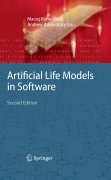
The advent of powerful processing technologies and the advances in software development tools have drastically changed the approach and implementation of computational research in fundamental properties of living systems through simulating and synthesizing biological entities and processes in artificial media.Nowadays realistic physical and physiological simulation of natural and would-be creatures, worlds and societies becomes a low-cost task for ordinary home computers. The progress in technology has dramatically reshaped the structure of the software, the execution of a code, and visualization fundamentals. Thishas led to the emergence of novel breeds of artificial life software models, including three-dimensional programmable simulation environment, distributed discrete events platforms and multi-agent systems. This second edition reflectsthe technological and research advancements, and presents the best examples of artificial life software models developed in the World and available for users. INDICE: From the contents Part I Virtual Environments.- Avida: A Software Platform for Research in Computational Evolutionary Biology.- Foundations of and Recent Advances in Artificial Life Modeling with Repast 3 and Repast Simphony.- Sodarace: Continuing Adventures in Artificial Life.- 3D Multi-Agent Simulations in the Breve Simulation Environment.- Framsticks: Creating and Understanding Complexity of Life.- Part II Lattice Worlds.- Starlogo TNG: Making AgentBased Modeling Accessible and Appealing for Novices.- From Artificial Life toIn Silico Medicine: Netlogo as a Means of Translational Knowledge Representation in Biomedical Research.- Discrete Dynamics Lab: Tools for Investigating Cellular Automata and Discrete Dynamical Networks.- Einstein: A Multiagent-basedModel of Combat.- Part III Artificial Chemistries.- From Artificial Chemistries to Systems Biology: Software for Chemical Organization Theory.- Spatially Resolved Artificial Chemistry.- Part IV Artificial Life Arts.
- ISBN: 978-1-84882-284-9
- Editorial: Springer
- Encuadernacion: Cartoné
- Páginas: 442
- Fecha Publicación: 15/06/2009
- Nº Volúmenes: 1
- Idioma: Inglés
